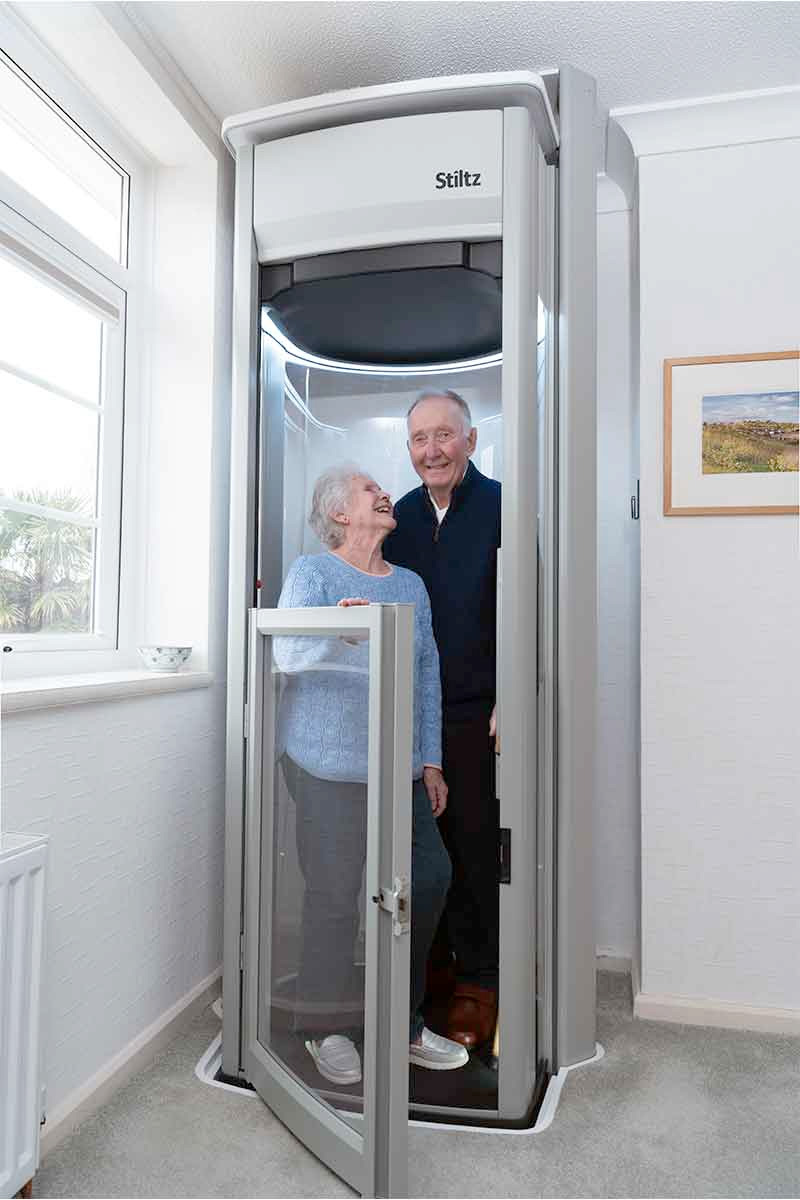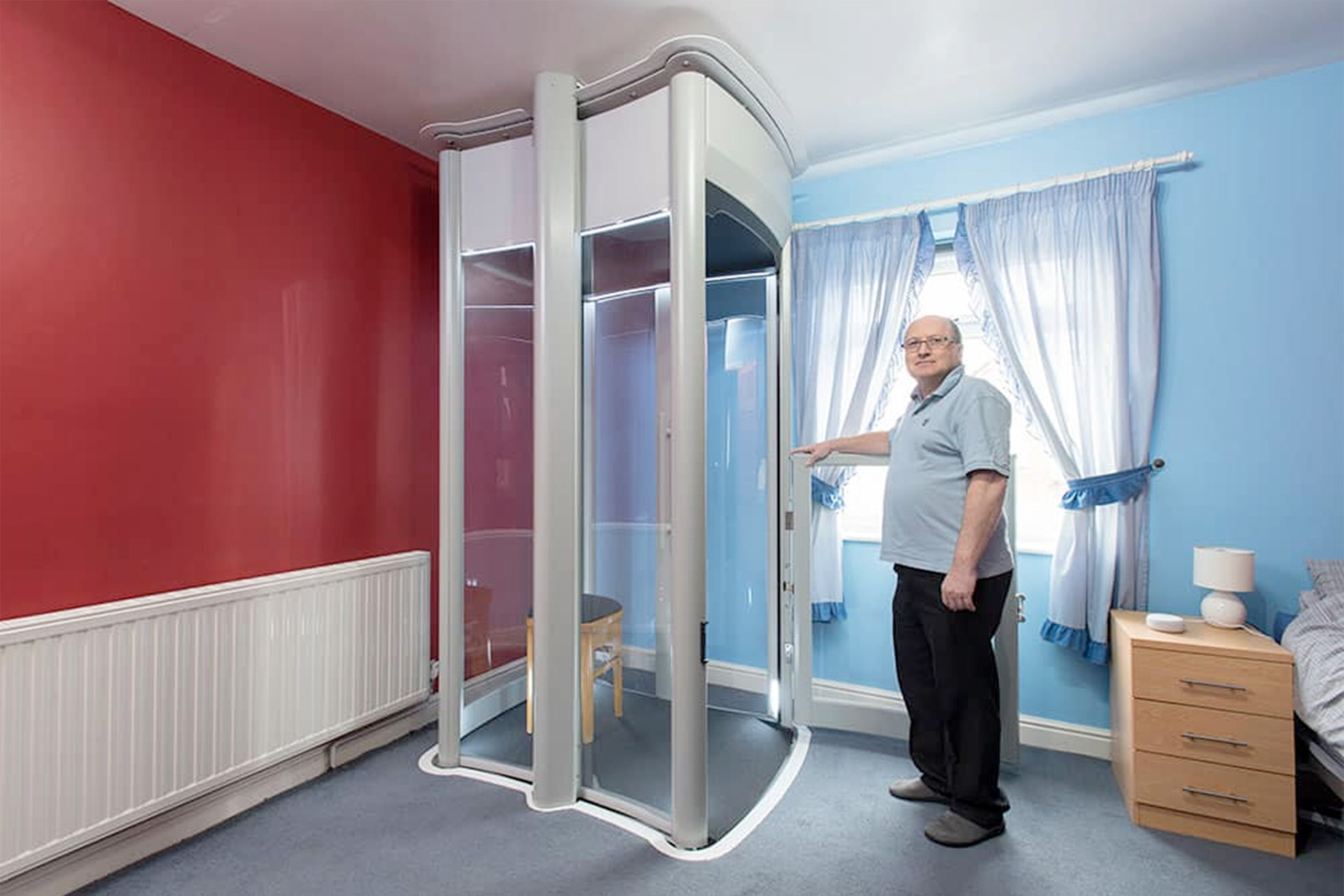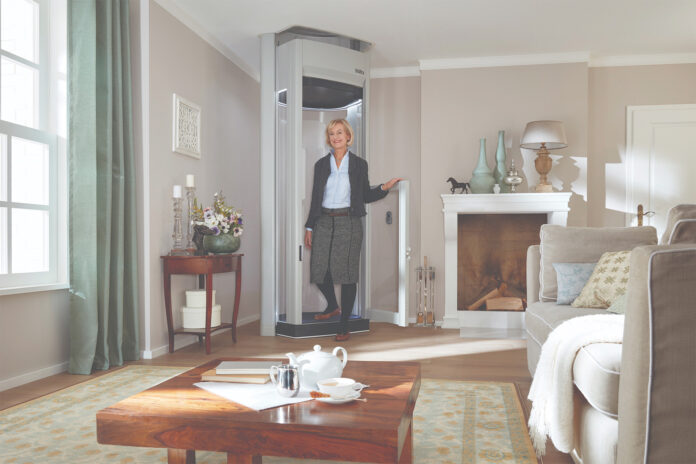Adding a residential lift to a single‑family home is increasingly feasible thanks to designs that minimise construction impact. The Stiltz “Home Lift” series (sometimes also referred to as a home elevator) is one such product—designed for installation in homes with less disruption, compact footprints and built‑in safety sensors. This article reviews the technical features, installation factors and limitations of Stiltz lifts, with an aim to help a homeowner decide whether it may suit their needs.
Design and construction
Stiltz lifts use a self‑supporting “dual‑rail” or “stilts” structure, meaning the lift car and guide rails carry their own load rather than relying on heavy shaft walls or full‑blown elevator machine rooms. For example, one spec sheet notes: “Self‑supporting structure – two parallel and vertical guides bear the load of the lift.”
Because of this structural approach, the unit has flexibility for placement in homes—such as in a stairwell void, corner of a room, landing area or even closet space. Installers highlight that minimal external hydraulics or visible hoists are required, and the drive components are concealed in the car roof space.
The units are marketed for relatively easy installation: in one region the spec sheet states the lift “plugs directly into domestic power sockets” and in the event of power outage “a battery backup will gently return you to the ground until power is restored.”
Capacity and model options
There are different model variants. One example: the “Duo Alta” model has a maximum load of 375 lbs (≈170 kg) for two people.
The “Trio Alta” version is designed for more space and heavier loads (for example accommodating a standard‑sized wheelchair) with a maximum load of up to 550 lbs in some spec sheets.

Footprint‑wise, the smaller Duo range can be installed in quite constrained space. For instance, one listing shows the Duo footprint as approximately 42″ wide by 30″ deep (≈1.07 m × 0.76 m) for one version.
In terms of travel height and speed, one spec states a maximum travel of 13′1″ (≈4 m) for the Duo model, and a speed of about 6″ per second (≈15 cm/s).
Safety and sensor systems
Safety is a key selling point. All models include a smart LED light curtain as standard, which “can detect obstacles and gently bring the lift to a stop if the light is crossed.” Additional safety sensors are placed at the top and bottom of the car—if an obstruction is detected, motion is halted immediately.
Other safety features described include built‑in braking mechanisms, load sensors to prevent over‑weight operation, door interlocks (lift only moves when car door is fully closed), and battery backup in case of power failure.

Because of the light curtain and obstruction sensors, the unit is relatively “smart” in the sense of detecting impediments at the entrance. That links directly to the idea of a home lift that “stops the moment something crosses its path.”
Installation and home integration
Installing such a lift in an existing home appears to involve fewer structural changes than a traditional full‑shaft elevator. In one UK overview it is claimed that “installation takes just one day once the ceiling aperture has been created by a qualified builder.”
The footprint is small—one example suggests a Duo+ model has a footprint of approximately 0.55 m² (less than seven square feet).
Because the drive and hoist are self‑contained, and no large machine‑room is needed, the disruption is reduced compared with conventional lifts. The power supply requirement is modest: many models run off a standard household outlet (e.g., 13 amp in UK versions).
From a home‑design perspective, the freedom of placement (corner, landing, closet) can make this a more feasible retrofit option. However, some building work is still required (floor opening, structural reinforcement, clearances). One US dealer’s installation description notes that drywall removal, joist doubling and other modifications may be needed.
Limitations and considerations
While the Stiltz lift offers many practical features, it’s important to note certain limitations. The maximum travel height is typically one floor (as indicated by model specs). Many homes have multiple floors or greater floor‑to‑floor heights which require careful checking. For instance, it may not be suitable for very tall or multi‑storey installs without additional modifications.

Capacity limits (375 lbs for one model, up to ~550 lbs for another) mean the homeowner must check that their usage (people, heavy loads, wheelchair + companion) aligns with the model specs. Users with multiple heavy users, large wheelchairs, or loads may require larger or different solutions.
Footprint and clearance remain relevant: even though space is small, you still need to allocate a pit or floor opening (for through‑floor models) and structural support for the load. Power outage backup is provided, but the descent in power failure scenario is usually to lower level, not full operation until power returns.
Another consideration: servicing and compliance—lifts installed in homes still require ongoing maintenance and likely inspections depending on local code/regulation. Additionally, while the design is marketed as “minimal disruption,” home owners must still factor in costs and structural work.
Practical insight for homeowners
If you are considering adding a home lift, the Stiltz Home Lift offers a reasonably flexible, compact option with built‑in safety sensing that addresses common concerns (footprint, aesthetics, obstruction detection). For example, if you have a two‑storey house, want to move between ground and first floor, and want a solution with minimal visual disruption, a self‑contained lift may make sense.
On the other hand, if you anticipate moving large furniture regularly between floors, have heavy users, require multi‑floor travel, or have limited structural headroom/floor‐to‐floor clearance, you will want to compare specs and installation requirements carefully. A home visit, structural survey and review of building codes are advisable before proceeding.
The practical benefit of the light‑curtain obstruction sensor is that it supports a “hands‑free” safety approach: the system checks for impediments at the entrance and stops motion if something crosses the beam. That is a useful safety feature, especially in a home setting where children, pets or objects might intervene.

Pricing and summary
While specific U.S. market pricing for the Stiltz Home Lift is not always published in full detail, one UK supplier states that “prices start from £12,000” for the home lift range, with building work, lift size and accessories affecting overall cost.
Home owners in the U.S. seeking a quote will need a site survey to determine total cost (unit plus installation, structural work, electrical modifications, finishing).
In summary, the Stiltz Home Lift represents a viable home elevator option that brings compact design, safety sensors such as light curtains, and more flexible installation into the home environment. It is not the lowest‑cost or simplest “chair‑lift” option, nor is it suitable for every floor layout or capacity need—but for many modern two‑storey homes it may offer a compelling balance of features.
Source: Stiltz Home Lifts



